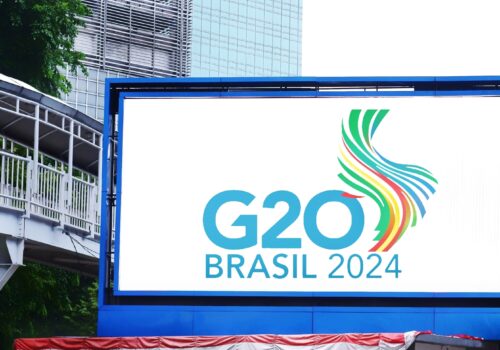Infra
What should digital public infrastructure look like? The G7 and G20 offer contrasting visions.

The Group of Seven’s (G7) recent entry into the digital public infrastructure (DPI) debate marks an important shift in the winds of global digital governance. It’s as if the G7, which released its latest Industry, Technology, and Digital Ministerial Declaration in March, wants to send a not-so-subtle message: “We’ve arrived at the DPI party, and we’ve got some thoughts.” And indeed, they do.
For well over a year, DPI discussions have simmered in capitals around the world, drawing in policymakers, diplomats, and development experts alike. As a quick primer on DPI, think of it as the digital equivalent of laying down highways and bridges, but for the virtual world. Just as physical infrastructure drives economic growth, investing in DPI can propel inclusive development at a societal scale. Identity, payments, and data exchange platforms are often cited as the core building blocks of DPI, mirroring the multilayered structure of India’s famous homegrown technology stack.
India has been a trailblazer in deploying DPI at home and globalizing the DPI model. With its Group of Twenty (G20) presidency in 2023, New Delhi championed DPI on the world stage, securing political buy-in for the concept at the highest levels. G20 digital ministers endorsed a framework to govern the design, development, and deployment of DPI last August. And with the unanimous endorsement of G20 leaders, the New Delhi Leaders’ Declaration from last November set the stage for accelerated DPI development in 2024.
However, as the G7’s foray into the DPI arena reveals, the conversation is far from over. There are still different views of what DPI is and ought to be, as well as how it should shape the way markets function. Contrasting the G7 and G20 ministerial texts on DPI reveal three important areas of contention.
Differing visions
First, there’s the question of scope and purpose: Should DPI focus on enhancing public service delivery by governments or seek to restructure markets and delivery of private services? The G7 ministerial text opts for a narrower focus, solely emphasizing DPI’s role in enhancing citizen access to public services delivered by governments, while the G20 imagines a more expansive canvas, where DPI serves as a conduit for “equitable access” to both public and private services. This distinction is not merely academic; it gets to the core of what makes DPI novel and contested.
What does it mean to use DPI to enable equitable access to private services at a societal scale? It’s an evolving concept, but the basic thrust is to leverage the design, deployment, and governance of DPI to “dynamically create and shape new markets” and advance policy goals. For example, with a market-shaping DPI in place, a system operator, often the state itself, can define technical standards for private service providers to ensure interoperability. It can cap market share to give force to its vision of competition policy. It can influence pricing and business strategies through system rules and design features, with the DPI operator playing the role of “market orchestrator.” This is a different paradigm for the digital economy than a traditional market-led model—and to DPI champions, that’s precisely the point.
Second, consider the motivations for deploying DPI: Should these include advancing competition policy objectives? When describing the objectives for deploying DPI, G7 ministers borrow from the G20 framework but make a notable omission: There is no reference to “competition” as a core rationale for DPI. This omission is fully consistent with the G7’s vision of DPI, narrowly focused on public service delivery by governments. For the G7, the task of building competitive markets for the private sector is left to national regulators and antitrust authorities, not DPI builders and operators.
By contrast, the G20’s framework invokes the role of DPI in promoting competition twice, and that’s no accident. All governments want competitive digital ecosystems, but some see overexposure to Western tech giants as compounding the risks posed by pure market concentration alone. In this context, deployment of DPI serves two related purposes: disrupting entrenched incumbent positions while increasing state capacity to offer core digital services that reduce reliance on Western tech firms.
Third, what about design principles? Should DPI require open-source tech and open standards? The G7 ministerial statement omits all specific references to open source or open standards; instead, it vigorously defends the role of the private sector in building interoperable elements of DPI, presumably using open or proprietary technologies. In comparison, the G20’s DPI framework pointedly and repeatedly emphasizes the need for open software, open standards, and open application programming interfaces (APIs). Ultimately, however, the G20 statement hedges on this question, stating that DPI can be built on “open source and/or proprietary solutions, as well as a combination of both.”
Nevertheless, speak to DPI theorists shaping G20 and Global South thinking on DPI, and it’s clear they see “openness” as a defining principle of well-built DPI, citing the role open architectures, open-source tech, and open APIs play in enabling transparency, scale, interoperability, and reduced risk of vendor lock-in. Still, fuzziness around the term “openness” and its application in some of the largest DPI systems deployed to date suggests there is much left to unpack.
How will the G7 engage with DPI going forward?
It’s clear that the G7’s vision for DPI differs from the G20’s in at least three important areas. The question that remains is what comes next: How will the G7 (or its member states) assert their point of view?
The G7’s ministerial text offers some early clues. It acknowledges that G7 members will have “different approaches to the development of digital solutions, including DPI” and notes that the upcoming G7 Compendium on Digital Government Services will collect “relevant examples of digital public services from G7 members.” The compendium would also summarize factors that have led to “successful deployment and use of digital government services, such as national strategies, investment, public procurement practices, governance frameworks, and partnerships.”
Developing the compendium is a good start. But looking ahead, G7 members will need to weigh in this year at fast-moving multilateral discussions during Brazil’s G20 presidency, for instance, or within the United Nations’ multiple DPI workstreams. In each case, G7 perspectives on corporate governance, privacy, market disciplines, and regulatory best practices will strengthen discussions and outcomes, just as the G20’s and the Global South’s focus on inclusion, competition, and openness help ground the conversation in public interest concerns. The push and pull of the different visions for DPI could yield a better outcome for all—that’s the optimistic case.
A pessimist may insist that the gaps between the G7 and G20 views on DPI are tough to bridge. And it’s true, there is a real difference between a DPI scoped for public service delivery and one intended to shape the structure of digital markets and digital services offered by the private sector. If the latter view of DPI holds, G7 member states may need to find new ways to constructively participate in global DPI discussions. This could involve promoting individual layers of the DPI stack, as the G7 is already doing with digital ID governance, and emphasizing the need for sustainable public-private partnerships for DPI build-out.
Ultimately, time will tell how the G7 chooses to lean into the global DPI debate. The only certainty is that the G7’s active engagement isn’t optional anymore—it’s essential.
Anand Raghuraman is a nonresident senior fellow at the Atlantic Council’s South Asia Center, where he leads research initiatives on US-India digital cooperation and publishes expert commentary on Indian data governance and digital policy initiatives. He is also director of global public policy at Mastercard.
Mastercard, through its Policy Center for the Digital Economy, is a financial supporter of an Atlantic Council project on digital public infrastructure.
The views expressed in this article are the author’s and do not necessarily reflect those of Mastercard.
Further reading
Fri, Apr 12, 2024
Brazil’s approach to the G20: Leading by example
Econographics
By
Hung Tran
Brazil’s non-aligned, cooperative, and practical approach holds out the promise of a constructive outcome for this year’s G20 meetings—especially if progress is measured by concrete global initiatives.
Image: In this photo illustration, the 50th G7 2024 summit logo of the Group of Seven is seen on a smartphone and a pc screen. The 50th G7 summit is scheduled to take place from 13 to 15 June 2024 in Italy. Pavlo Gonchar / SOPA Images/Sipa USA via Reuters Connect.











